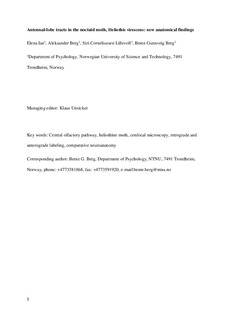| dc.contributor.author | Ian, Elena | |
| dc.contributor.author | Berg, Aleksander | |
| dc.contributor.author | Lillevoll, Siri Corneliussen | |
| dc.contributor.author | Berg, Bente Gunnveig | |
| dc.date.accessioned | 2019-05-07T14:40:43Z | |
| dc.date.available | 2019-05-07T14:40:43Z | |
| dc.date.created | 2016-09-13T11:14:40Z | |
| dc.date.issued | 2016 | |
| dc.identifier.citation | Cell and Tissue Research. 2016, 366 (1), 23-35. | nb_NO |
| dc.identifier.issn | 0302-766X | |
| dc.identifier.uri | http://hdl.handle.net/11250/2596863 | |
| dc.description.abstract | As in other insects, three main tracts in the moth brain form parallel connections between the antennal lobe and the protocerebrum. These tracts, which consist of the antennal-lobe projection-neuron axons, target two main areas in the protocerebrum, the calyces of the mushroom bodies and the lateral horn. In spite of the solid neuroanatomical knowledge already established, there are still unresolved issues regarding the antennal-lobe tracts of the moth. One is the proportion of lateral-tract neurons targeting the calyces. In the study presented here, we have performed both retrograde and anterograde labeling of the antennal-lobe projection neurons in the brain of the moth, Heliothis virescens. The results from the retrograde staining, obtained by applying dye in the calyces, demonstrated that the direct connection between the antennal lobe and this neuropil is maintained primarily by the medial antennal-lobe tract; only a few axons confined to the lateral tract were found to innervate the calyces. In addition, these staining experiments, which allowed us to explore the arborization pattern of labeled neurons within the antennal lobe, resulted in new findings regarding anatomical arrangement of roots and cell body clusters linked to the medial tract. The results from the anterograde staining, obtained by applying dye into the antennal lobe, visualized the total assembly of axons passing along the antennal-lobe tracts. In addition to the three classical tracts, we found a transverse antennal-lobe tract not previously described in the moth. Also, these staining experiments revealed an organized neuropil in the lateral horn formed by terminals of the four antennal-lobe tracts. | nb_NO |
| dc.language.iso | eng | nb_NO |
| dc.publisher | Springer | nb_NO |
| dc.title | Antennal-lobe tracts in the noctuid moth, Heliothis virescens: New anatomical findings | nb_NO |
| dc.type | Journal article | nb_NO |
| dc.type | Peer reviewed | nb_NO |
| dc.description.version | acceptedVersion | nb_NO |
| dc.source.pagenumber | 23-35 | nb_NO |
| dc.source.volume | 366 | nb_NO |
| dc.source.journal | Cell and Tissue Research | nb_NO |
| dc.source.issue | 1 | nb_NO |
| dc.identifier.doi | 10.1007/s00441-016-2448-0 | |
| dc.identifier.cristin | 1380733 | |
| dc.description.localcode | © Springer-Verlag Berlin Heidelberg 2016. This is a post-peer-review, pre-copyedit version of an article published in Cell and Tissue Research. The final authenticated version is available online at: http://dx.doi.org/10.1007/s00441-016-2448-0 | nb_NO |
| cristin.unitcode | 194,67,40,0 | |
| cristin.unitname | Institutt for psykologi | |
| cristin.ispublished | true | |
| cristin.fulltext | original | |
| cristin.qualitycode | 1 | |
